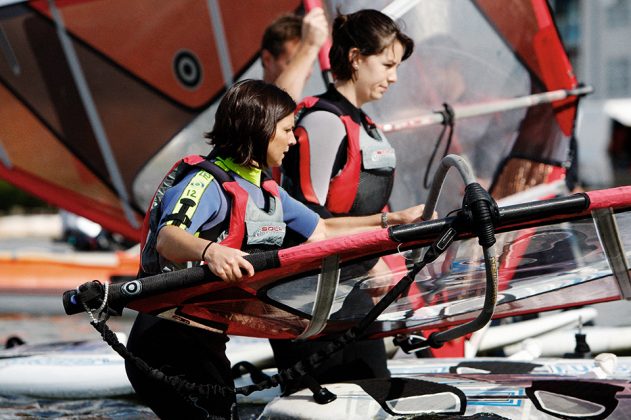For many people new to windsurfing that can often mean committing to buying their own kit for the first time. But how do you make sure you invest in the correct kit to keep you progressing, and not get so frustrated with the sport you give it up? Read on as the RYA tell us how to make the right choices.
Words & Photo RYA
Originally published within the June ’17 edition
Back to basics
If you’re even considering buying your first bit of kit, chances are you might have already had a few ‘taster’ sessions, or done the first course in the RYA’s National Windsurfing Scheme (adults) or Youth Windsurfing Scheme (U16s), depending on your age. This is the best way to get a handle on what starter kit you need. “Always take lessons before buying equipment,” explains RYA Chief Instructor Dinghy and Windsurfing, Amanda Van Santen. “By continuing tuition, and taking a few more lessons and completing part, or all, of your Intermediate or Youth Stage 3 and 4 courses, your proficiency will improve quickly and you will be at a better stage to invest in equipment.”
Kit talk
In terms of your sailing equipment, ‘kit’ is generally considered in terms of the board and rig (sail, boom, mast, mastfoot, uphaul etc). There are lots of styles, sizes and brands of boards out there, and which you go for can depend on three factors – your ability, your size and what type of sailing you’re most likely to be doing (wave, racing, bump and jump, blasting, freestyle etc). For starter kit, your two primary considerations when buying a board are its buoyancy – or ‘volume’ as it’s known – and width. Volume is measured in litres, with one litre supporting one kilogram of weight. The basic calculation to work out what volume you require can be broken down as:
• Your weight in kilos +
• Rig weight when wet +
• Board weight wet with mast base, straps and fin
• Total converted from kilos to litres
• Add or subtract the volume adjustments of sailor ability, intended use and predominant wind conditions.
The width of a board helps with stability, and can sometimes be a better way to judge suitability than volume. Wider boards are generally more stable, able to plane earlier, carry larger fins and sails and are bouncier in chop. A narrower board is typically more suited to lighter sailors or stronger winds.
Beginner rigs tend not to have battens – the stiff, flexible rods that pass across a sail to give extra power, stability and shape – but as you progress you want a sail that is going to give you better performance. When buying your first rig, look for something light but that does have battens. The same sorts of considerations need to be made for buying kids’ rigs. A young sailor needs light sails so they can pull the sail up and hold on to it. Again the board needs to be the right size; not too big they can’t turn it around, but equally not too small they can’t stand and balance on it. The RYA Start and Intermediate Handbooks both have great advice on buying kit.
Getting geared up
A decent, versatile wetsuit is a must. You might also consider buying windsurfing boots, gloves and a rash vest as part of your personal clothing, while as you progress you will doubtless want to get a harness to suit the type of windsurfing you want to do too. A buoyancy aid is also top of the priorities list when learning. A buoyancy aid will help keep your confidence high when you’re trying to master new skills, such as planing and water starts. Being covered by at least Third Party Insurance is sensible too, in case you do have a close shave with another windsurfer or water user. This level of cover is free for windsurfing RYA members, through Bishop Skinner Marine.
Where to go?
Your instructors will have a good idea what equipment will be most suited to you and quite often there will be a shop attached to the training centre too. Other windsurfers at the centre, or friends you’ve made through the sport, will also be able to pass on useful information. Like with most things nowadays there is a buoyant second-hand market as well. But this is a path that must be trodden carefully. Get the best advice you can so you don’t end up buying a board that’s too small and meant for more advanced sailors for example, or buy rigs or sails that are too big or heavy due to design, age or size. Once you have your own kit, the world is your oyster, but getting the right kit is key.
For more advice and information, training courses or to purchase RYA publications, visit www.rya.org.uk.
PHOTO Correct kit selection will make your progress easier and good advice will help you avoid mistakes in purchasing.

